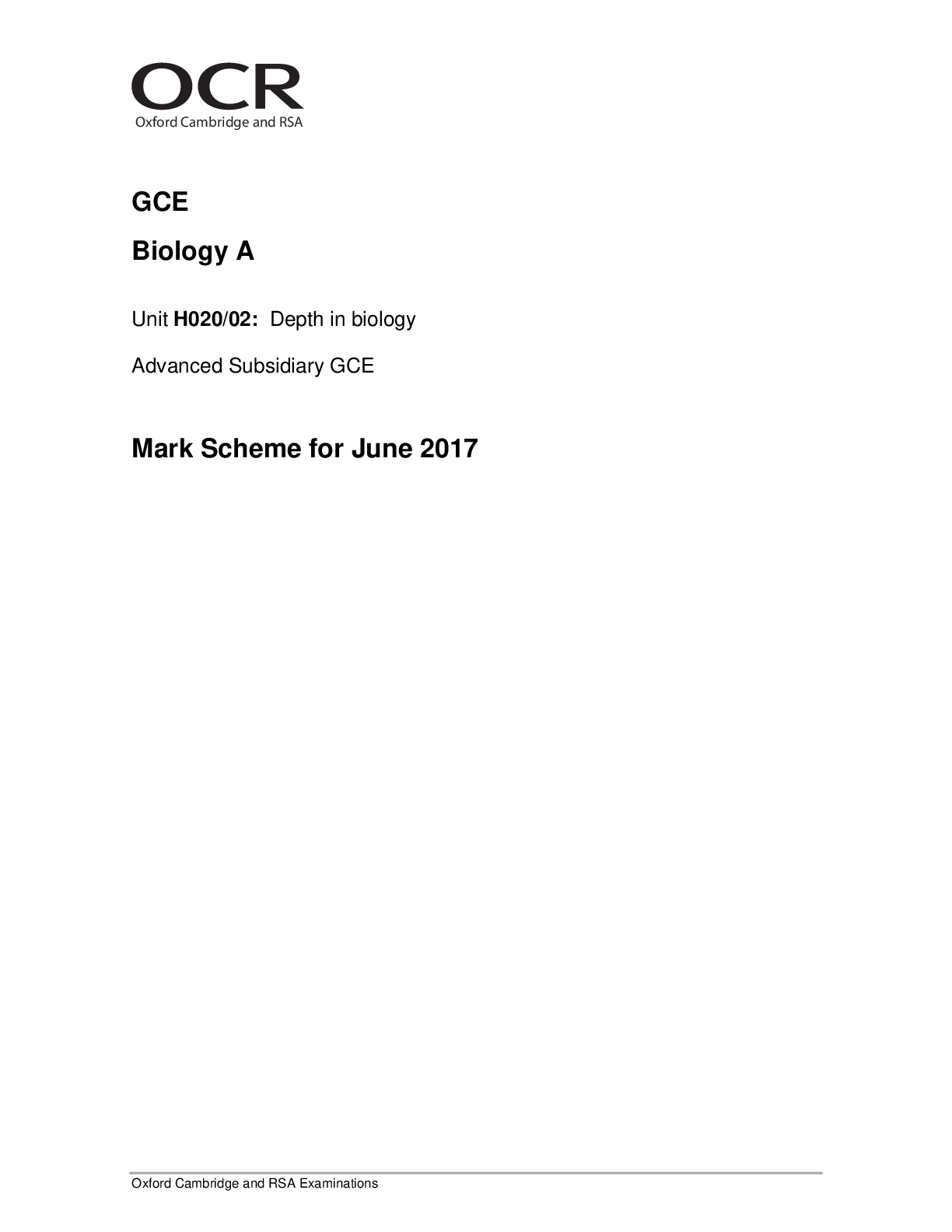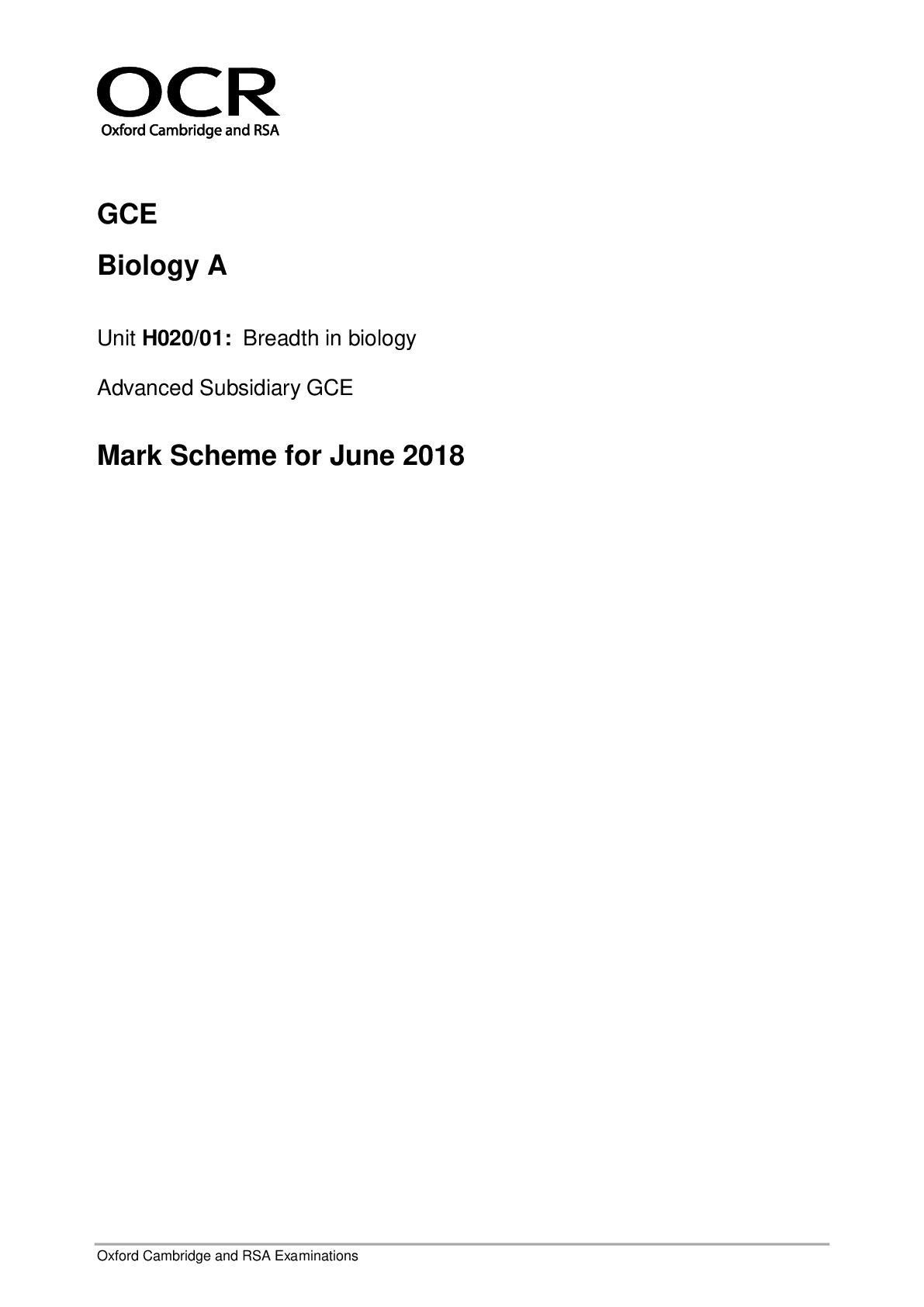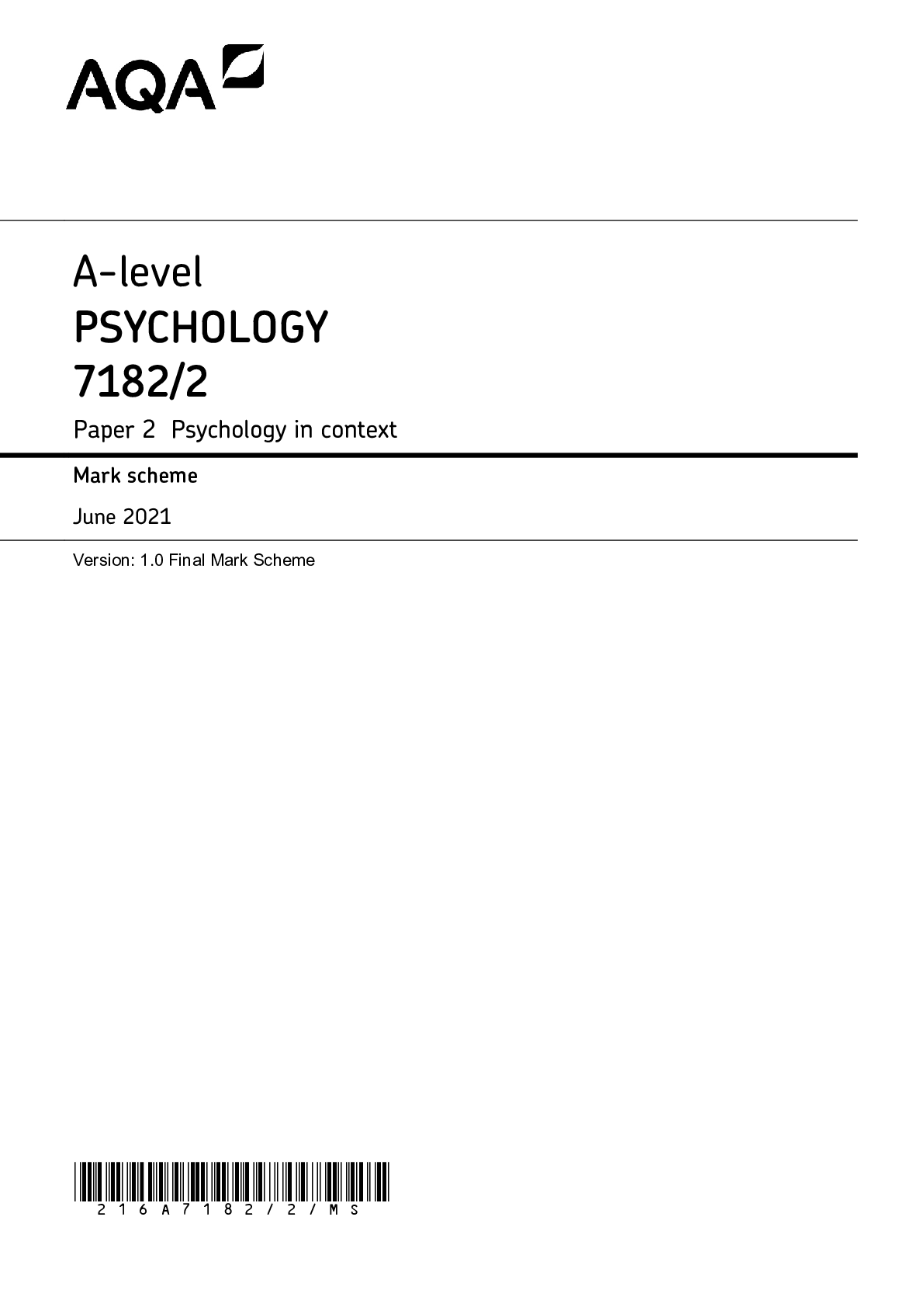Health Care > MARK SCHEMES > OCR Chemistry A H032/01: Breadth in chemistry AS Level Mark Scheme for June 2022 (All)
OCR Chemistry A H032/01: Breadth in chemistry AS Level Mark Scheme for June 2022
Document Content and Description Below
OCR Chemistry A H032/01: Breadth in chemistry AS Level Mark Scheme for June 2022 GCE Chemistry A H032/01: Breadth in chemistry AS Level Mark Scheme for June... 2022 OCR (Oxford Cambridge and RSA) is a leading UK awarding body, providing a wide range of qualifications to meet the needs of candidates of all ages and abilities. OCR qualifications include AS/A Levels, Diplomas, GCSEs, Cambridge Nationals, Cambridge Technicals, Functional Skills, Key Skills, Entry Level qualifications, NVQs and vocational qualifications in areas such as IT, business, languages, teaching/training, administration and secretarial skills. It is also responsible for developing new specifications to meet national requirements and the needs of students and teachers. OCR is a not-for-profit organisation; any surplus made is invested back into the establishment to help towards the development of qualifications and support, which keep pace with the changing needs of today’s society. This mark scheme is published as an aid to teachers and students, to indicate the requirements of the examination. It shows the basis on which marks were awarded by examiners. It does not indicate the details of the discussions which took place at an examiners’ meeting before marking commenced. All examiners are instructed that alternative correct answers and unexpected approaches in candidates’ scripts must be given marks that fairly reflect the relevant knowledge and skills demonstrated. Mark schemes should be read in conjunction with the published question papers and the report on the examination. © OCR 2022 Longer Answer Questions (requiring a developed response) Where candidates have provided two (or more) responses to a medium or high tariff question which only required a single (developed) response and not crossed out the first response, then only the first response should be marked. Examiners will need to apply professional judgement as to whether the second (or a subsequent) response is a ‘new start’ or simply a poorly expressed continuation of the first response. 6. Always check the pages (and additional objects if present) at the end of the response in case any answers have been continued there. If the candidate has continued an answer there, then add a tick to confirm that the work has been seen. 7. Award No Response (NR) if: • there is nothing written in the answer space Award Zero ‘0’ if: • anything is written in the answer space and is not worthy of credit (this includes text and symbols). Team Leaders must confirm the correct use of the NR button with their markers before live marking commences and should check this when reviewing scripts. 8. The RM Assessor comments box is used by your team leader to explain the marking of the practice responses. Please refer to these comments when checking your practice responses. Do not use the comments box for any other reason. If you have any questions or comments for your team leader, use the phone, the RM Assessor messaging system, or e-mail. 9. Assistant Examiners will send a brief report on the performance of candidates to their Team Leader (Supervisor) via email by the end of the marking period. The report should contain notes on particular strengths displayed as well as common errors or weaknesses. Constructive criticism of the question paper/mark scheme is also appreciated. 10. For answers marked by levels of response: Not applicable in F501 a. To determine the level – start at the highest level and work down until you reach the level that matches the answer b. To determine the mark within the level, consider the following Descriptor Award mark On the borderline of this level and the one below At bottom of level Just enough achievement on balance for this level Above bottom and either below middle or at middle of level (depending on number of marks available) Meets the criteria but with some slight inconsistency Above middle and either below top of level or at middle of level (depending on number of marks available) Consistently meets the criteria for this level At top of level 11. Annotations available in RM Assessor Annotation Meaning Correct response Incorrect response Omission mark Benefit of doubt given Contradiction Rounding error Error in number of significant figures Error carried forward Level 1 Level 2 Level 3 Benefit of doubt not given Noted but no credit given Ignore Blank page 12. Abbreviations, annotations and conventions used in the detailed Mark Scheme (to include abbreviations and subject-specific conventions). Annotation Meaning DO NOT ALLOW Answers which are not worthy of credit IGNORE Statements which are irrelevant ALLOW Answers that can be accepted ( ) Words which are not essential to gain credit Underlined words must be present in answer to score a mark ECF Error carried forward AW Alternative wording ORA Or reverse argument 13. Subject-specific Marking Instructions INTRODUCTION Your first task as an Examiner is to become thoroughly familiar with the material on which the examination depends. This material includes: • the specification, especially the assessment objectives • the question paper • the mark scheme. You should ensure that you have copies of these materials. You should ensure also that you are familiar with the administrative procedures related to the marking process. These are set out in the OCR booklet Instructions for Examiners. If you are examining for the first time, please read carefully Appendix 5 Introduction to Script Marking: Notes for New Examiners. Please ask for help or guidance whenever you need it. Your first point of contact is your Team Leader. SECTION A Question Answer Marks AO element Guidance 1 B 1 AO1.1 2 A 1 AO1.1 3 D 1 AO1.1 4 C 1 AO2.1 ALLOW 7 5 D 1 AO1.2 ALLOW Ar 6 B 1 AO2.1 7 C 1 AO2.2 8 B 1 AO2.4 9 D 1 AO2.6 10 D 1 AO1.1 11 A 1 AO2.2 12 D 1 AO1.1 13 A 1 AO2.6 14 D 1 AO1.2 ALLOW 9 15 C 1 AO1.2 ALLOW 12 16 D 1 AO2.6 17 D 1 AO1.2 18 B 1 AO1.1 19 A 1 AO2.5 20 C 1 AO2.5 Total 20 SECTION B Question Answer Marks AO element Guidance 21 (a) (i) 3,3-dimethylbut-1-ene CARE: Look for dimethyl 1 AO1.2 1 IGNORE lack of hyphens, or addition of commas or spaces ALLOW full stops or spaces between numbers e.g. 3.3 dimethyl but-1-ene DO NOT ALLOW meth OR methy (ii) ANNOTATE ANSWER WITH TICKS AND CROSSES 5 For curly arrows, ALLOW straight or snake-like arrows and small gaps (see examples): 1st curly arrow must • go to a Br atom of Br–Br AND • start from, OR be traced back to any point across width of C=C 2nd curly arrow must • start from, OR be traced back to, any part of +Br–Br– bond • AND go to Br – 1st curly arrow (from ANY alkene) Curly arrow from double bond to Br of Br–Br DO NOT ALLOW partial charge on C=C AO1.2 2nd curly arrow Correct dipole on Br–Br AND curly arrow for breaking of Br–Br bond AO1.2 Question Answer Marks AO element Guidance 3rd curly arrow Correct carbocation with + charge on C with 3 bonds AND curly arrow from Br– to C+ of carbocation DO NOT ALLOW δ+ on C of carbocation OR i.e. ALLOW carbonium + on either C atom Correct product to match mechanism/intermediate DO NOT ALLOW half headed or double headed arrows but allow ECF if seen more than once Name of mechanism: Electrophilic addition IGNORE connectivity of CH3 groups in carbocation and product and ALLOW C4H9 AO2.5 3rd curly arrow must • go to the C+ of carbocation AND • start from, OR be traced back to any point across width of lone pair on :Br– • OR start from – charge on Br– ion (Lone pair NOT needed if curly arrow shown from – charge on Br–) AO2.5 ALLOW bromonium ion ALLOW any combination of skeletal OR structural OR displayed formula as long as unambiguous NOTE: For a mechanism with HBr, ALLOW all marks EXCEPT for final product mark AO1.1 (b) (i) 1 For repeat unit, Question Answer Marks AO element Guidance • ‘side bonds’ required on either side of repeat unit from C atoms • ALLOW more than one repeat unit • ALLOW C4H9 for C(CH3)3 Correct polymer with side links ? AO2.5 1 IGNORE brackets • IGNORE n IGNORE connectivity of C(CH3)3 group (b) (ii) Advantage: Energy/electricity (produced) AND Disadvantage: CO2 produced OR gases causing global warming/climate change OR greenhouse gases, e.g CO2 BOTH advantage and disadvantage 1 AO1.1 1 ALLOW reduced use of fossil fuels IGNORE produced CO2 and H2O ALLOW less landfill / less harm to wildlife or environment (not just harmful) ALLOW toxic/poisonous (waste) products/gases, e.g. CO IGNORE harmful/dangerous Question Answer Marks AO element Guidance 22 (a) FIRST CHECK ANSWER ON THE ANSWER LINE IF answer = 190.47 (to 2 DP) award 2 marks (188 12.13) + (189 16.75) + (190 27.23) + (192 43.89) 100 OR 190.4677 OR 190.468 = 190.47 (to 2 DP) 2 AO1.2 2 For 1 mark: ALLOW ECF to 2 DP if: • %s used with wrong isotopes ONCE OR • transposed decimal places for ONE % (b) ? ? Mark by row 2 AO1.2 2 Easiest to check element first ALLOW P3– ALLOW names for elements IGNORE charges with element in 1st column, even if wrong. For electron configuration, ALLOW 4s2 before 3d8 i.e. 1s22s22p63s23p64s23d8 ALLOW upper case D, etc and subscripts, e.g 4S23D1 ALLOW [Ar)3d84s2 Question Answer Marks AO element Guidance (c) Molar ratios Zn : H : N : O = 21.99 : 4.04 : 9.41 : 64.56 65.4 1.0 14.0 16.0 OR 0.336 : 4.04 : 0.672 : 4.04 OR 1 : 12 : 2 : 12 Empirical formula ZnH12N2O12 Any order With water of crystallisation ZnN2O6•6H2O OR Zn(NO3)2•6H2O -------------------------------------------------------------------------- Inverse fractions NO MARKS 3 AO1.2 2 AO2.2 1 NOTE: If only the correct answer of ZnN2O6•6H2O OR Zn(NO3)2•6H2O is seen with no working, award 1 mark only ALLOW ECF from incorrect molar ratios of Zn : H : N : O e.g. from use of atomic number(s) ALLOW Zn(NO3)2(H2O)6 ALLOW ECF from incorrect empirical formula e.g. ZnNO3•3H2O from ZnH6NO6 Question Answer Marks AO element Guidance 23 (a) (i) (Electrostatic) attraction between oppositely charged OR + and – ions 1 AO1.1 1 Attraction is essential IGNORE references to metal and non-metal (ii) 2 AO1.2 2 ALLOW labels if seen outside circles provided it clear which circle the label applies to ALLOW 1 mark for Mg AND S shown alternately, each in FOUR circles i.e. with no charges or incorrect charges ALLOW 1 mark for 2+/+2 AND 2–/–2 shown alternately in FOUR circles (with no Mg and S) DO NOT ALLOW All circles with same ion, i.e. all Mg2+ OR all S2– [Show More]
Last updated: 2 years ago
Preview 1 out of 26 pages

Buy this document to get the full access instantly
Instant Download Access after purchase
Buy NowInstant download
We Accept:

Reviews( 0 )
$12.00
Can't find what you want? Try our AI powered Search
Document information
Connected school, study & course
About the document
Uploaded On
Jan 10, 2023
Number of pages
26
Written in
Additional information
This document has been written for:
Uploaded
Jan 10, 2023
Downloads
0
Views
78




 October 2020 Pearson Edexcel GCE In AS Level Mathematics 8MA0 Paper 1 Pure Mathematics.png)









